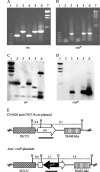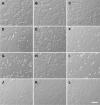Epsilon-toxin plasmids of Clostridium perfringens type D are conjugative
- PMID: 17720791
- PMCID: PMC2168747
- DOI: 10.1128/JB.00767-07
Epsilon-toxin plasmids of Clostridium perfringens type D are conjugative
Abstract
Isolates of Clostridium perfringens type D produce the potent epsilon-toxin (a CDC/U.S. Department of Agriculture overlap class B select agent) and are responsible for several economically significant enterotoxemias of domestic livestock. It is well established that the epsilon-toxin structural gene, etx, occurs on large plasmids. We show here that at least two of these plasmids are conjugative. The etx gene on these plasmids was insertionally inactivated using a chloramphenicol resistance cassette to phenotypically tag the plasmid. High-frequency conjugative transfer of the tagged plasmids into the C. perfringens type A strain JIR325 was demonstrated, and the resultant transconjugants were shown to act as donors in subsequent mating experiments. We also demonstrated the transfer of "unmarked" native epsilon-toxin plasmids into strain JIR325 by exploiting the high transfer frequency. The transconjugants isolated in these experiments expressed functional epsilon-toxin since their supernatants had cytopathic effects on MDCK cells and were toxic in mice. Using the widely accepted multiplex PCR approach for toxin genotyping, these type A-derived transconjugants were genotypically type D. These findings have significant implications for the C. perfringens typing system since it is based on the toxin profile of each strain. Our study demonstrated the fluid nature of the toxinotypes and their dependence upon the presence or absence of toxin plasmids, some of which have for the first time been shown to be conjugative.
Figures




Similar articles
-
Virulence plasmid diversity in Clostridium perfringens type D isolates.Infect Immun. 2007 May;75(5):2391-8. doi: 10.1128/IAI.02014-06. Epub 2007 Mar 5. Infect Immun. 2007. PMID: 17339362 Free PMC article.
-
Necrotic enteritis-derived Clostridium perfringens strain with three closely related independently conjugative toxin and antibiotic resistance plasmids.mBio. 2011 Sep 27;2(5):e00190-11. doi: 10.1128/mBio.00190-11. Print 2011. mBio. 2011. PMID: 21954306 Free PMC article.
-
pCP13, a representative of a new family of conjugative toxin plasmids in Clostridium perfringens.Plasmid. 2019 Mar;102:37-45. doi: 10.1016/j.plasmid.2019.02.002. Epub 2019 Feb 18. Plasmid. 2019. PMID: 30790588
-
Toxin plasmids of Clostridium perfringens.Microbiol Mol Biol Rev. 2013 Jun;77(2):208-33. doi: 10.1128/MMBR.00062-12. Microbiol Mol Biol Rev. 2013. PMID: 23699255 Free PMC article. Review.
-
Clostridium perfringens type A-E toxin plasmids.Res Microbiol. 2015 May;166(4):264-79. doi: 10.1016/j.resmic.2014.09.004. Epub 2014 Oct 2. Res Microbiol. 2015. PMID: 25283728 Free PMC article. Review.
Cited by
-
Whole genome analysis reveals the diversity and evolutionary relationships between necrotic enteritis-causing strains of Clostridium perfringens.BMC Genomics. 2018 May 22;19(1):379. doi: 10.1186/s12864-018-4771-1. BMC Genomics. 2018. PMID: 29788909 Free PMC article.
-
Sequencing and diversity analyses reveal extensive similarities between some epsilon-toxin-encoding plasmids and the pCPF5603 Clostridium perfringens enterotoxin plasmid.J Bacteriol. 2008 Nov;190(21):7178-88. doi: 10.1128/JB.00939-08. Epub 2008 Sep 5. J Bacteriol. 2008. PMID: 18776010 Free PMC article.
-
Virulence Plasmids of the Pathogenic Clostridia.Microbiol Spectr. 2019 May;7(3):10.1128/microbiolspec.gpp3-0034-2018. doi: 10.1128/microbiolspec.GPP3-0034-2018. Microbiol Spectr. 2019. PMID: 31111816 Free PMC article.
-
In silico Identification of Novel Toxin Homologs and Associated Mobile Genetic Elements in Clostridium perfringens.Pathogens. 2019 Jan 29;8(1):16. doi: 10.3390/pathogens8010016. Pathogens. 2019. PMID: 30699957 Free PMC article.
-
Functional characterization and localization of the TcpH conjugation protein from Clostridium perfringens.J Bacteriol. 2008 Jul;190(14):5075-86. doi: 10.1128/JB.00386-08. Epub 2008 May 16. J Bacteriol. 2008. PMID: 18487333 Free PMC article.
References
-
- Abraham, L. J., A. J. Wales, and J. I. Rood. 1985. Worldwide distribution of the conjugative Clostridium perfringens tetracycline resistance plasmid, pCW3. Plasmid 14:37-46. - PubMed
-
- Brynestad, S., and P. E. Granum. 1999. Evidence that Tn5565, which includes the enterotoxin gene in Clostridium perfringens, can have a circular form which may be a transposition intermediate. FEMS Microbiol. Lett. 170:281-286. - PubMed
Publication types
MeSH terms
Substances
Grants and funding
LinkOut - more resources
Full Text Sources
Other Literature Sources

